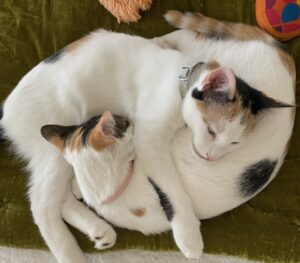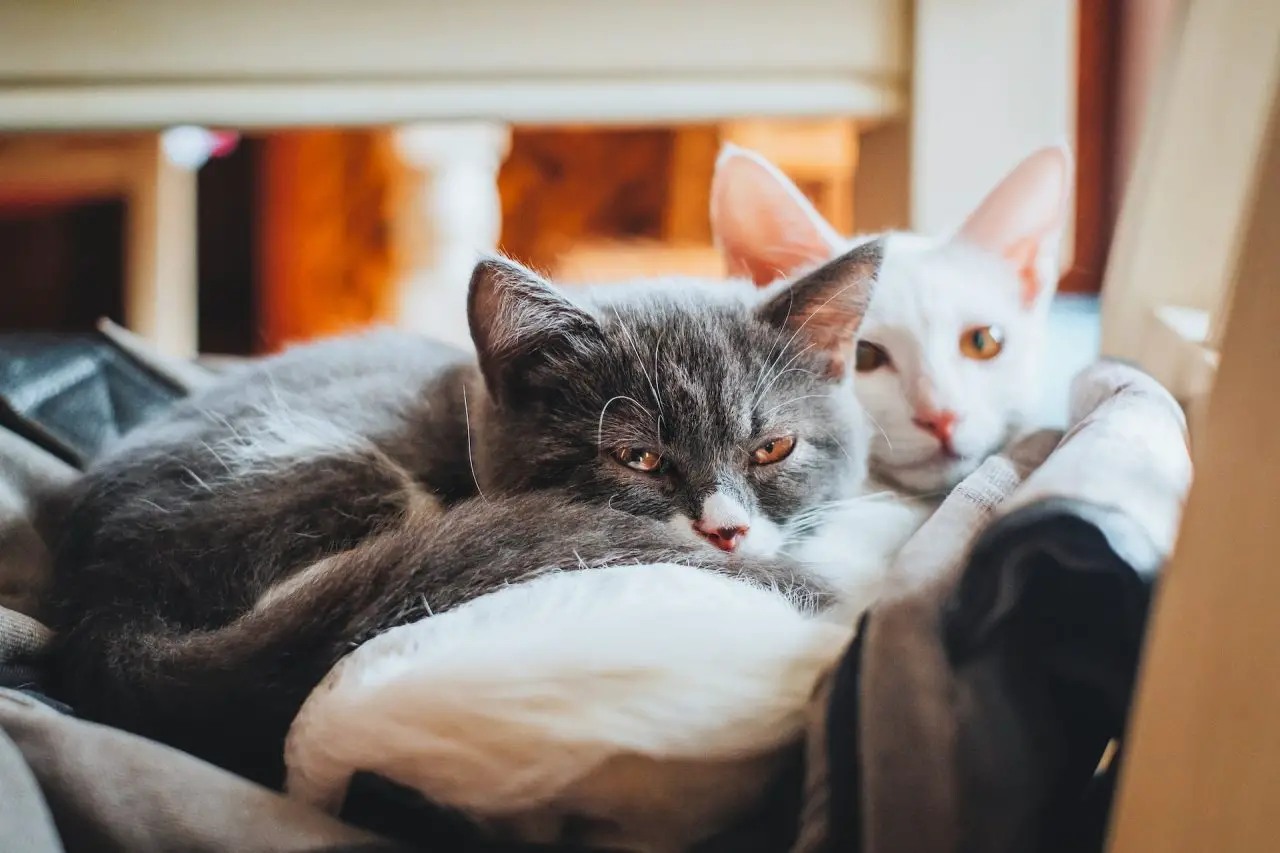Separating bonded cats can lead to depression and behavior issues in cats that have been together for a long time. Animal shelters prioritize keeping bonded cats together to prevent these negative effects.
The Importance Of Bonded Cats
When you separate bonded cats, they may suffer from depression and behavior issues. Cats form tight friendships, and it can be difficult to separate them, especially if they have been together for many years. It’s best to keep bonded cats together to maintain their emotional well-being.
Cats Can Form Strong Bonds With Each Other
- Cats have the ability to form strong emotional attachments with other cats.
- Bonded cats share a unique social relationship characterized by companionship, trust, and dependency.
- These bonds are often formed between littermates or cats that have spent a significant amount of time together.
- The bond between cats is reinforced through common activities such as grooming, sleeping, and playing together.
The Challenges Of Separating Bonded Cats
- Separating bonded cats can be a challenging and emotional experience for both the cats and their owners.
- Bonded cats may experience confusion, stress, and anxiety when separated from their companion.
- The loss of a bonded partner can lead to behavioral problems in the remaining cat, such as decreased appetite, excessive vocalization, or even aggression.
- Owners may also struggle with guilt and sadness when making the decision to separate their bonded cats.
Understanding The Emotional Impact On Bonded Cats
- Bonded cats rely on each other for companionship and emotional support.
- Separating bonded cats can result in feelings of loneliness and isolation for the remaining cat.
- Cats that have been separated from their bonded partner may exhibit signs of depression, such as lethargy and a lack of motivation.
- It is important for owners to provide extra attention, affection, and playtime to help alleviate the emotional distress of a separated bonded cat.
Bonded cats share a strong emotional connection, and separating them can have a significant impact on their well-being. Owners should consider the emotional needs of their cats and seek alternatives to separation whenever possible. If separation is unavoidable, providing additional love and support can help mitigate the emotional distress experienced by bonded cats.
Remember to always prioritize the welfare and happiness of your feline companions.
Signs Of Bonded Cats
Breaking up a bonded pair of cats can lead to depression and behavior issues. These feline friendships are strong, and it’s best to keep them together if possible. Animal shelters make an effort to place bonded cats together to ensure their well-being.
How To Identify Bonded Cats:
- Pay attention to their behavior towards each other: Bonded cats are often seen grooming each other, cuddling, or sleeping together.
- Look for signs of distress when separated: Bonded cats may become anxious, exhibit signs of depression, or display disruptive behavior when kept apart.
- Observe their communication: Bonded cats have a unique way of communicating with each other through body language, vocalizations, and even scent marking.
- Consider their history: Cats that have been together for a long time or have been through traumatic experiences together are more likely to form a strong bond.
Behaviors And Actions That Indicate A Strong Bond:
- Mutual grooming: Bonded cats will often groom each other, showing affection and strengthening their bond.
- Sleeping together: Cats that are bonded will often choose to sleep close to each other or even cuddle.
- Playing together: Bonded cats enjoy engaging in playtime together, chasing each other or sharing toys.
- Protective behavior: If one cat tries to approach another bonded cat, they may display protective behavior, such as hissing or growling.
- Shared territory: Bonded cats demonstrate a willingness to share their living spaces, including sleeping areas, food bowls, and litter boxes.
The Benefits Of Keeping Bonded Cats Together:
- Emotional wellbeing: Bonded cats provide each other with companionship, reducing loneliness and stress levels.
- Social interaction: Having a bonded partner allows cats to engage in natural feline behaviors, such as grooming, playing, and practicing social skills.
- Reduced behavioral issues: Separating bonded cats can lead to behavioral problems like aggression or anxiety.
- Easier adjustment: When bonded cats are kept together in a new environment, they can provide each other with comfort and support during the transition.
By recognizing the signs of bonded cats and understanding the benefits of keeping them together, you can ensure the well-being and happiness of these feline companions. Remember, a bonded pair should be kept together whenever possible, as their strong bond is essential for their overall health and happiness.
The Consequences Of Separating Bonded Cats
Separating bonded cats can have negative consequences, such as depression and behavior issues. It is important to keep bonded pairs together and avoid separating them, as they have formed strong feline friendships that are difficult to break. Animal shelters prioritize placing bonded cats together to ensure their well-being.
Behavioral Issues That May Arise:
- Separating bonded cats can lead to a range of behavioral issues due to the emotional stress they experience. Some of the common issues include:
- Aggression towards other animals or humans.
- Excessive vocalization or meowing.
- Marking territory by spraying urine.
- Increased anxiety and fearfulness.
- Decreased appetite or overeating.
The Risk Of Depression In Separated Cats:
- Cats are highly social animals, and when separated from their bonded companion, they can experience depression. Depression in cats can manifest in various ways, including:
- Loss of interest in activities and decreased playfulness.
- Changes in sleeping patterns, either sleeping excessively or having trouble sleeping.
- Weight loss or gain.
- Excessive grooming or neglecting grooming altogether.
- Withdrawal and avoiding interaction with humans or other animals.
Long-Term Effects On The Overall Well-Being Of The Cats:
- Separating bonded cats can have long-term effects on their overall well-being. These effects can impact their physical and mental health, leading to:
- Weakened immune system and increased susceptibility to illnesses.
- Chronic stress, which can contribute to the development of various diseases.
- Reduced lifespan and quality of life.
- Difficulty forming new bonds and trusting other animals or humans.
- Increased risk of developing behavioral problems even after they are rehomed.
Remember, it is important to consider the bond between cats and the potential consequences before making the decision to separate them.
Separating Bonded Cats: Proper Approach And Considerations
When you separate bonded cats, they may experience depression and behavior issues. It is important to consider the close bond between the cats and the potential negative effects of separation, especially if they have been together for a long time.
Animal shelters often make an effort to keep bonded pairs together.
Ting bonded cats? Yes, it is possible to separate bonded cats, but it should be approached with careful consideration and the proper techniques to minimize stress and ensure a successful reunion. Below are some tips on how to separate bonded cats and reintroduce them properly:
Minimizing Stress During Separation:
- Provide separate comfortable spaces: Before separating the cats, make sure to create separate spaces for each of them with their own food, water, litter boxes, and bedding. This will help them feel secure during the separation.
- Use positive reinforcement: Make the separation a positive experience by providing treats, toys, and affection to each cat during their time apart. This will help them associate the separation with positive rewards.
- Maintain routine and familiarity: Stick to the cats’ regular feeding and playtime schedule to provide a sense of familiarity and comfort during the separation.
- Provide environmental enrichment: Keep each cat engaged and stimulated with toys, scratching posts, and interactive play to reduce stress and prevent boredom during the separation period.
Gradual Separation Techniques:
- Start with short separations: Begin by separating the cats for short periods, gradually increasing the duration over time. This allows them to adjust and get used to being apart.
- Use visual barriers: Initially, use a baby gate or screen door to separate the cats while still allowing them to see and smell each other. This helps them become familiar with the idea of being separated while maintaining a level of interaction.
- Swap bedding and scents: Exchange bedding between the cats so they can become accustomed to each other’s scent. This can help ease the transition during the separation.
- Rotate living spaces: Switch the cats’ living spaces periodically so they can become familiar with each other’s scent and territory.
Tips For Reintroducing Separated Cats:
- Gradual re When the cats have spent enough time apart, slowly reintroduce them in neutral territory, such as a separate room or a space they both have not been in before.
- Supervise their interactions: Monitor their initial interactions closely to ensure that they are getting along and not displaying any signs of aggression or distress.
- Positive reinforcement: Reward good behavior during the reintroduction process with treats, praise, and attention. This helps create positive associations between the cats.
- Seek professional guidance if needed: If the cats continue to display aggression or have difficulty adjusting, consult with a veterinarian or animal behaviorist for further guidance and support.
Separating bonded cats can be a challenging process, but with the right approach and consideration, it is possible to successfully separate and reintroduce them. By minimizing stress during separation, using gradual separation techniques, and following proper reintroduction tips, you can help ensure a smooth transition for your bonded cats.
Rebuilding Bonds Between Separated Cats
When you separate bonded cats, they may suffer from depression and behavior issues. It can be difficult to separate a bonded pair, especially if they have been together for a long time. Animal shelters make an effort to keep bonded cats together to prevent these issues.
The bond between two cats can be incredibly strong, and separating them can have a significant impact on their well-being. When bonded cats are separated, they may experience depression or behavioral issues. However, if it becomes necessary to separate them, there are strategies you can use to rebuild their bond or establish a new one.
In this section, we will explore these strategies for reintegrating bonded cats.
Strategies For Reintegrating Cats:
- Gradual re Slowly reintroduce the cats to each other in a controlled environment, such as separate rooms with a barrier or a shared space with plenty of hiding spots.
- Scent swapping: Exchange bedding or toys between the cats to allow them to become familiar with each other’s scent.
- Positive reinforcement: Reward desirable behavior, such as calm interactions or sharing resources, with treats or praise to encourage a positive association.
- Play therapy: Engage the cats in interactive play sessions together to help them bond through shared positive experiences.
- Controlled feeding: Feed the cats near each other but with a safe distance, gradually reducing the distance over time. This can help create positive associations with each other’s presence.
Slowly Re-Establishing Their Bond:
- Allow the cats to set the pace: Each cat will have its own comfort level when it comes to rebuilding their bond. Respect their boundaries and give them time to adjust.
- Supervised interaction: Initially, closely monitor the cats’ interactions to prevent any aggressive behavior. Gradually increase the duration of their interactions as they become more comfortable with each other.
- Provide vertical space: Install cat trees or shelves to give the cats opportunities to observe each other from a safe height, which can help reduce tension and build trust.
- Feline pheromone diffusers: Consider using synthetic feline pheromones, such as Feliway, diffusers in the home to create a calming environment and promote bonding.
Building A New Bond If Necessary:
- Introduce a neutral territory: If the previous attempts to reintegrate the cats have not been successful, start the bonding process in a completely new environment, such as a separate room or a neutral area outside the home.
- Gradually expand their territory: Slowly allow the cats to explore more areas of the home together as they become more comfortable and their bond strengthens.
- Positive reinforcement: Use treats, playtime, and praise to reward positive interactions between the cats, reinforcing their new bond.
Remember, the process of rebuilding or building a bond between separated cats takes time and patience. It’s essential to create a positive and stress-free environment to increase the chances of a successful reunion. By following these strategies, you can help your separated cats rebuild their bond and establish a harmonious relationship once again.
Seeking Professional Advice And Support
Breaking apart a bonded pair of cats can have negative consequences, including depression and behavior issues. Animal shelters make an effort to keep bonded cats together.
Consulting With A Veterinarian Or Animal Behaviorist:
- It is advisable to consult with a veterinarian or animal behaviorist before making any decisions regarding separating bonded cats.
- These professionals have the expertise and knowledge to assess the cats’ behaviors, emotions, and overall well-being.
- They can provide guidance and advice based on the specific situation and the cats’ individual needs.
- Veterinarians and animal behaviorists can offer insights into alternative solutions or interventions to support the cats’ bond while addressing any concerns.
Resources For Assistance In Dealing With Bonded Cat Separation:
- There are various resources available for individuals seeking support and guidance when dealing with separating bonded cats.
- Local animal shelters and rescue organizations often have experience and knowledge in handling bonded cats and can provide valuable advice.
- Online forums and communities dedicated to cat care and behavior can offer insights and personal experiences from individuals who have gone through similar situations.
- Books and articles written by experts in the field can provide in-depth information and strategies for managing bonded cat separation.
- Pet support hotlines or helplines may be available in certain areas, providing a direct line of communication with professionals who can offer guidance and support.
Understanding When Separation Is Necessary For The Cats’ Well-Being:
- While separating bonded cats should be a last resort, there are situations where it may be necessary for the well-being of the cats involved.
- Physical aggression between the cats that poses a risk to their safety or health may require separation.
- Chronic stress or fear responses in one or both cats despite intervention efforts may indicate the need for separation.
- In cases where one cat has a medical condition that requires specialized care or a different environment, separation may be necessary.
- Ultimately, the decision to separate bonded cats should be made with careful consideration of their individual needs and the guidance of professionals.

Credit: rnrpets.org
Frequently Asked Questions For What Happens If You Separate Bonded Cats
What Happens When You Break A Bonded Pair Of Cats?
When you break a bonded pair of cats, they may suffer from depression or behavior issues. Animal shelters work hard to keep them together.
Can You Split A Bonded Pair?
What happens if you separate bonded cats? Separating bonded pairs of cats can lead to depression and behavior issues. It’s best to keep them together.
Can A Bonded Pair Of Cats Become Unbonded?
Bonded cats can become unbonded, leading to depression and behavior issues when separated. Animal shelters work to keep bonded pairs together.
Can You Separate Bonded Cats For A Few Hours?
Yes, you can separate bonded cats for a few hours, but it is best to keep them together to avoid any issues upon reunion.
What Happens When You Separate Bonded Cats?
When bonded cats are separated, they may experience depression or behavior issues due to the loss of their close companion.
Conclusion
Separating bonded cats can have significant consequences on their well-being. Cats that have formed a strong bond with each other may experience depression and behavioral issues when separated. Animal shelters recognize the importance of keeping bonded pairs together and make efforts to find them a home where they can remain together.
It is essential to prioritize the bond between these cats, even when faced with the temptation of adopting just one of them. While it may be possible to separate bonded cats for short periods, it is best to keep them together whenever possible, as some cats may not recognize each other upon reunion, leading to potential conflicts.
Studies have shown that bonded cats are more socially adjusted and tend to live longer, happier lives when they are allowed to remain together. So, it is crucial to consider the well-being of these cats and keep them together if they have formed a strong bond.


